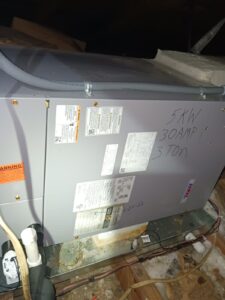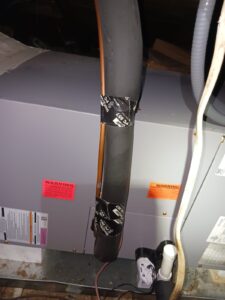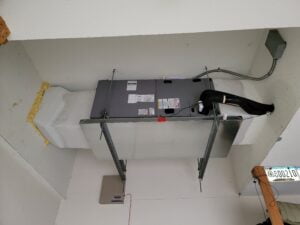What are drain pans?
Primary and secondary drain pans are essential components in your HVAC (Heating, Ventilation, and Air Conditioning) system, working quietly behind the scenes to safeguard your home or business.
Primary Drain Pan: The primary drain pan is the first line of defense against moisture buildup. It collects condensation produced during the cooling process and safely directs it out of your system. However, if the primary drain pan becomes clogged or damaged, it can lead to water leaks and potential damage to your property.
Secondary Drain Pan: The secondary drain pan serves as a crucial backup in case the primary pan fails. It’s strategically placed beneath the primary pan to catch any excess water or condensate. When the secondary pan detects moisture, it triggers an alarm, alerting you to the issue. This early warning system can prevent costly water damage and disruption to your HVAC system.
Both primary and secondary drain pans play pivotal roles in maintaining a comfortable indoor environment and preventing potential disasters. Regular maintenance and attention to these often-overlooked components can ensure your HVAC system operates smoothly and efficiently.
Importance of Maintaining Drain Pans
Maintaining both primary and secondary drain pans in your HVAC system is of paramount importance to ensure the efficiency, longevity, and safety of your system and property. Let’s delve into the significance of maintaining these essential components:
1. Preventing Water Damage: Primary drain pans are designed to collect condensation and moisture generated during the cooling process. If these pans become clogged or develop leaks due to neglect, they can lead to water damage within your property. Regular maintenance ensures that these pans function as intended, safeguarding your home or business from costly water-related issues.
2. Avoiding Mold and Bacterial Growth: Stagnant water in drain pans can become a breeding ground for mold, mildew, and bacteria. When left unchecked, these contaminants can negatively impact indoor air quality, potentially leading to health issues for occupants. Proper maintenance, including cleaning and sanitizing the drain pans, helps prevent microbial growth and ensures a healthier indoor environment.
3. Secondary Pan as a Safety Net: The secondary drain pan serves as a crucial safety net in case the primary pan fails. It’s strategically positioned to catch excess moisture when the primary pan overflows or malfunctions. Regular maintenance of both pans, along with the secondary pan’s alarm system, ensures early detection and prevents potential water damage disasters.
4. Longevity of HVAC System: Neglecting drain pan maintenance can have a cascading effect on your HVAC system’s performance and lifespan. Excess moisture can lead to corrosion and damage to various components, ultimately reducing the efficiency and longevity of your HVAC system. Routine care of drain pans helps keep your HVAC system in peak condition.
5. Energy Efficiency: A well-maintained HVAC system operates more efficiently, consuming less energy. Clean and functioning drain pans contribute to the overall efficiency of the cooling process, reducing energy consumption and, consequently, lowering utility bills.

Signs of Drain Pan Problems
Recognizing the signs of drain pan problems in your HVAC system is crucial for timely maintenance and preventing potential damage. Here are some common signs to watch for:
- Water Leaks: Noticeable water leaks or moisture buildup around your HVAC unit can indicate a problem with the drain pans. This is a clear sign that the primary pan may be overflowing or the secondary pan is in use.
- Musty Odors: If you detect musty or moldy odors coming from your HVAC system, it could be due to microbial growth in the drain pans. Stagnant water provides an ideal breeding ground for mold and bacteria, leading to unpleasant odors.
- Reduced Cooling Efficiency: A decrease in the cooling efficiency of your HVAC system may be linked to drain pan issues. When the pans are clogged or damaged, excess moisture can affect the overall performance of the system.
- Unexplained Increase in Energy Bills: An unexpected spike in your energy bills could be a result of reduced HVAC system efficiency. If drain pans are not functioning correctly, your system may have to work harder to maintain the desired temperature, leading to higher energy consumption.
- Visible Rust or Corrosion: Inspect the drain pans for any signs of rust or corrosion. These can weaken the pans and lead to leaks or structural damage over time.
- Alarms or Alerts: Some HVAC systems are equipped with secondary drain pan alarms. If you hear an alarm or receive an alert, it’s a clear indication that the secondary pan has detected moisture, and there may be an issue with the primary pan.
- Poor Indoor Air Quality: Drain pan problems can contribute to poor indoor air quality. If you or your occupants experience allergies or respiratory issues, it could be due to microbial growth in the HVAC system, stemming from inadequately maintained drain pans.
- Visible Debris or Clogs: Inspect the drain pans for any visible debris, such as dirt, leaves, or algae growth. These obstructions can impede the proper flow of condensate and lead to pan issues.
- Secondary Pan Activation: If the secondary drain pan is activated, it means that the primary pan is unable to handle the moisture, and there may be a problem that requires attention.
- Water Stains or Damage: Check the area around your HVAC system for water stains or structural damage. These can be clear indicators that water has been escaping from the drain pans.
If you notice any of these signs of drain pan problems, it’s advisable to take prompt action. Regular maintenance and inspection of your HVAC system’s drain pans can help prevent more significant issues and ensure the continued efficient operation of your system.
DIY Drain Pan Maintenance
Maintaining your HVAC system’s drain pan is essential to prevent issues like water damage and mold growth. Since you’re The AC Therapist, a local HVAC contractor, I assume you have experience with this, but I’ll provide some DIY tips for drain pan maintenance for others who might be interested:
- Shut Off the Power: Before performing any maintenance on your HVAC system, turn off the power at the breaker to ensure your safety.
- Access the Drain Pan: Locate the drain pan, which is typically located beneath the evaporator coil inside your air handler or furnace.
- Inspect for Debris: Check the drain pan for any debris, such as dirt, dust, or algae. Remove any loose debris by hand.
- Clean the Pan: Use a mixture of warm water and mild detergent to clean the drain pan thoroughly. You can also add a little vinegar to the water to help break down any stubborn deposits. Scrub the pan gently with a soft brush.
- Check the Drain Line: Inspect the drain line connected to the drain pan. Ensure it’s clear of any clogs or blockages. If there’s a clog, you can use a wet/dry vacuum or a pipe cleaner to clear it.
- Add Algaecide Tablets: To prevent algae growth in the future, consider adding algaecide tablets to the drain pan. These tablets will help inhibit the growth of mold and algae.
- Regular Maintenance: Make it a habit to check and clean the drain pan at least once a year, ideally before the cooling season starts. This preventive measure can save you from costly repairs down the road.
- Test the Drain: After cleaning and reassembling everything, pour a small amount of water into the drain pan to ensure it drains properly and doesn’t overflow. If it does, you may need to adjust the drain line or call a professional for further assistance.
Remember that while these steps can help with basic drain pan maintenance, it’s always a good idea to have a professional HVAC technician, like The AC Therapist, perform regular maintenance and inspections to ensure the entire system is functioning optimally. If you offer maintenance services, you can also remind your customers of the importance of regular HVAC system maintenance, including drain pan cleaning.

Why Replace the Drain Pans?
- Preventing Water Damage: The primary purpose of these pans is to collect and safely channel condensate away from your HVAC system. Over time, these pans can corrode or develop cracks, potentially leading to water leaks. Replacing them ensures that water is properly managed, preventing costly damage to your property.
- Mold and Mildew Prevention: A malfunctioning primary pan can lead to water accumulation within your HVAC system, creating a breeding ground for mold and mildew. This not only affects indoor air quality but can also pose health risks. Replacing the pans helps maintain a clean and healthy environment.
- Avoiding System Failure: Water damage from pan leaks can extend beyond cosmetic issues. It can damage critical HVAC components like motors, circuit boards, and electrical connections, leading to system failure. Regular replacement helps prolong the life of your HVAC system.
- Compliance with Regulations: Depending on local building codes and regulations, HVAC systems may be required to have functional secondary drain pans. Replacing these pans ensures compliance with such regulations, avoiding potential legal issues.
When Should You Replace the Drain Pans?
- Age and Condition: If your HVAC system is several years old, it’s a good practice to inspect the drain pans for signs of wear, rust, or corrosion. If you notice any damage, it’s time for a replacement.
- Annual Maintenance: Including drain pan inspection and replacement as part of your annual HVAC maintenance routine is a proactive way to address potential issues before they become major problems.
- Visible Leaks: If you notice water pooling around your HVAC unit or signs of moisture, it’s crucial to investigate the source. A leaking primary pan could be the culprit.
Professional Replacement vs. DIY
While some homeowners may attempt DIY drain pan replacement, it’s a task best left to professionals, especially for complex HVAC systems. A licensed HVAC technician, like The AC Therapist, possesses the expertise and tools necessary to ensure a proper and safe replacement, including sealing, alignment, and testing.
The primary and secondary drain pans in your HVAC system play a vital role in preventing water damage and maintaining indoor air quality. Regular inspection and timely replacement are key to ensuring your HVAC system operates efficiently and trouble-free. If you suspect issues with your drain pans or require professional assistance, don’t hesitate to reach out to HVAC experts like The AC Therapist to keep your system running smoothly and your property protected.

How long do AC drain pans last?
The lifespan of an AC drain pan can vary depending on several factors, including the quality of the materials, the climate in which the HVAC system operates, and how well the system is maintained. On average, AC drain pans can last anywhere from 10 to 20 years. Here are some factors that can influence the lifespan of AC drain pans:
- Material Quality: The type of material used to make the drain pan plays a significant role in its longevity. Most drain pans are made of materials like plastic, metal, or composite materials. Higher-quality materials tend to last longer.
- Climate: In regions with high humidity or where the air conditioning system is used extensively throughout the year, drain pans may experience more condensate buildup and wear out faster.
- Maintenance: Regular maintenance of your HVAC system can extend the lifespan of the drain pan. This includes cleaning the drain pan, inspecting it for damage, and ensuring that the drain lines are clear. Neglecting maintenance can lead to premature deterioration.
- Corrosion: If your drain pan is made of metal, corrosion can be a concern, especially in coastal areas with salty air. Corrosion can weaken the pan and lead to leaks.
- Installation Quality: Proper installation is crucial for the longevity of the drain pan. If the pan is not installed correctly, it may be more prone to damage and leaks.
- Usage: The frequency and intensity of AC usage can affect the drain pan’s lifespan. Systems that run continuously or in extreme conditions may experience more wear and tear.
- Age of the HVAC System: As the HVAC system ages, the drain pan may also deteriorate. If you have an older HVAC system, it’s a good idea to inspect the drain pan during regular maintenance and consider replacement if it shows signs of wear.
- Type of Water Treatment: Some HVAC systems use water treatment solutions to prevent microbial growth in the drain pan. The type of treatment used and its effectiveness can impact the pan’s lifespan.
It’s important to note that the primary and secondary drain pans may have different lifespans. Secondary pans, being a backup, may last longer because they are used less frequently.
Regular inspections, maintenance, and timely replacement when necessary are essential for ensuring that your AC drain pans function effectively and prevent water damage to your property. If you suspect issues with your drain pans or your HVAC system, it’s advisable to consult with a licensed HVAC technician, like The AC Therapist, to assess the situation and perform any needed repairs or replacements.
Should the air conditioner drain pan be full of water?
No, the air conditioner drain pan should not be full of water under normal operating conditions. The primary function of the drain pan is to collect condensate that forms on the evaporator coil inside your HVAC system during the cooling process and then drain that water away. If the drain pan is full of water, it indicates a problem with the drainage system, which should be addressed promptly to prevent water damage and potential HVAC system issues.
What happens if the AC drain pan is full?
If the AC drain pan is full, it can lead to several potential problems and issues that need to be addressed promptly. Here are the consequences of a full AC drain pan:
- Water Damage: The primary concern with a full drain pan is the risk of water damage to your property. When the drain pan overflows or leaks due to being full, the accumulated water can cause damage to the surrounding area, including walls, ceilings, and flooring. Water damage can be expensive to repair and may also lead to mold and mildew growth, which can pose health risks.
- HVAC System Issues: A full drain pan can affect the proper functioning of your HVAC system. If water accumulates in the pan and overflows, it can potentially damage critical HVAC components, such as motors, circuit boards, and electrical connections. This can lead to system malfunctions and costly repairs.
- Reduced Efficiency: When the drain pan is full, it may obstruct the airflow within the HVAC system, reducing its efficiency. This can result in decreased cooling or heating performance and higher energy bills.
- Indoor Air Quality Concerns: Stagnant water in the drain pan can become a breeding ground for mold and bacteria. This can lead to a decline in indoor air quality as these contaminants are circulated through your HVAC system and into your living spaces.
- Unpleasant Odors: Mold and bacteria growth in the drain pan can produce unpleasant odors that are distributed throughout your home when the HVAC system operates.
Trust The AC Therapist for Expert Drain Pan Installation and Replacement
In conclusion, the installation and replacement of primary and secondary drain pans are vital aspects of HVAC maintenance that should not be overlooked. These seemingly humble components play a crucial role in preventing water damage, maintaining indoor air quality, and ensuring the efficient operation of your HVAC system.
As we’ve discussed in this blog, proper installation and regular maintenance of these pans can save you from costly repairs and property damage down the road. Whether you’re considering the installation of new pans or replacing old ones, it’s important to trust the job to professionals who have the expertise and experience to do it right.
That’s where The AC Therapist, your local residential and light commercial HVAC contractor in the Tampa Bay area, comes in. Their team of licensed HVAC technicians is well-equipped to handle all your HVAC needs, including drain pan installation, replacement, and maintenance. By relying on their services, you can ensure that your HVAC system operates smoothly, efficiently, and without the risk of water-related issues.
Don’t wait until a full drain pan leads to water damage or HVAC system problems. Reach out to The AC Therapist today for expert assistance in ensuring the longevity and performance of your HVAC system. With their Therapy Maintenance Plans and professional services, you can enjoy peace of mind knowing that your home or business’s comfort and safety are in capable hands.









